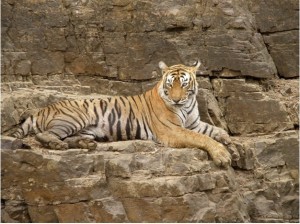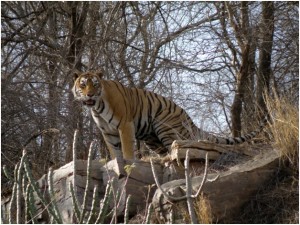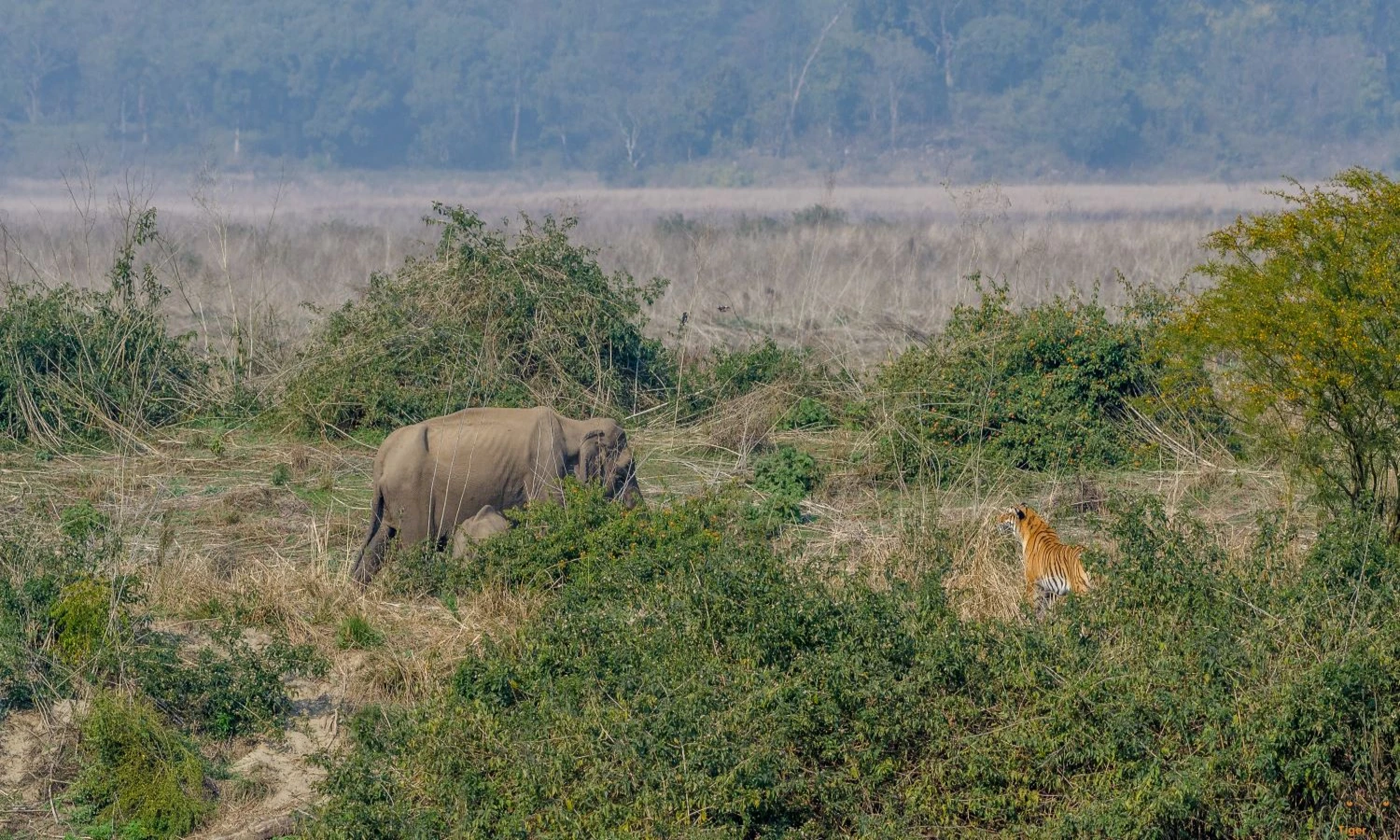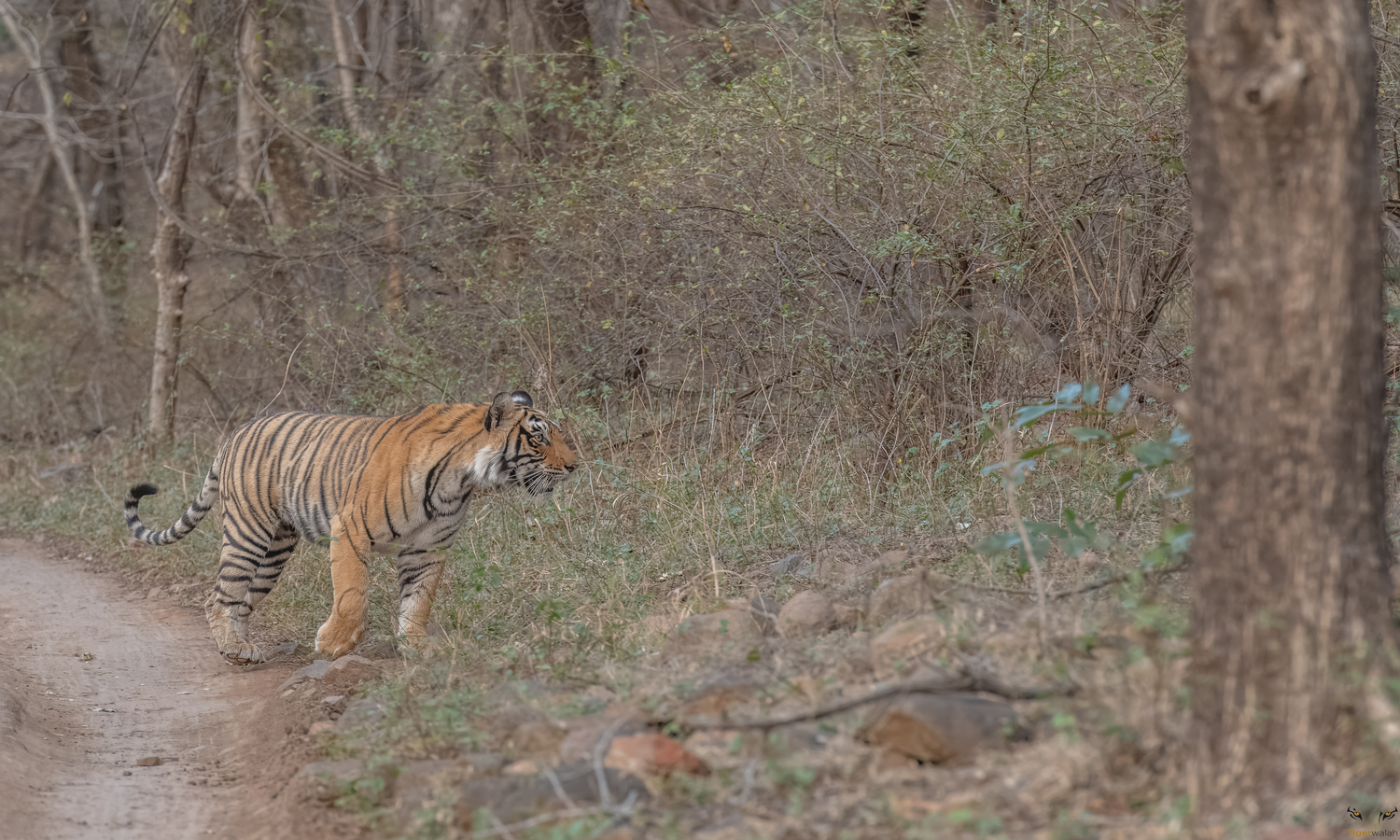My encounters with the Lady of the Lakes

Author: Soonoo Taraporewala
I have been visiting Ranthambhore regularly since 1983 when very few people even in India had heard about it. As a result, I’ve seen many, many changes, not always for the better. And I have grown to love the place more than any other, a love that planted its seed on my very first drive in the park. I got to know the park very well thanks to Fateh Singh Rathore who was the Field Director at the time. He would drive us around in his jeep, and whatever I know about wildlife or tigers is largely thanks to him. And so it was in April 2001 that I first encountered the legendary tigress known to most as Machhli, but whom I prefer to call the Lady of the Lakes. It was her mother who was called Machhli because she had a fish-shaped mark on her left cheek. Lady (as I will henceforth call her) has no fish-shaped mark on her face but has instead a fork-like mark on either side of her mouth.
In April 2001 I was staying at Maa Farm along with a friend, and so was the renowned photographer, John Isaac. At that time there were no fixed zones for tourists to visit, nor was there a roster system for drivers as there is today. One morning we were informed that Lady had been spotted with her two male cubs at Kamaldar, and drove there, Fateh Singh and John Isaac in one gypsy, my friend and I in another. And there she was, just before the road enters Nalghati around a tight curve, one cub cuddled up to her, and the other sitting a little way off near a spiky bush. She kept licking and grooming her cub and was relaxed in our presence. We watched, fascinated, as the cubs played about, and then returned to their mother. They were about ten months old – Broken Tail and his brother. Fateh Singh wondered what would happen as they grew older and would want to establish their territories, whether they would fight like Karan and Arjun. We watched for about an hour until Lady decided to get up. She wanted to lead her cubs away. As she did not want to pass us, she tried going towards Nalghati. But by then there were a few gypsies lined up on that narrow path, so she had to decide what to do. As clearly as though she was speaking, she seems to have instructed her cubs to remain at a spot at the entrance of the Nalghati road while she went on to explore. And unlike most human children, they remained there obediently, patiently waiting for her to tell them what to do next. She soon turned back, because of the gypsies there, and led the cubs the other way, past a shallow pool up to a small tree which she sprayed and scratched, and then led them away towards Jhalra. My friend declared that it was the happiest day of her life, and I had to agree that I was pretty elated myself.
Another memorable encounter came about three years later in May, once more along with Fateh Singh and an English guest who had hired the gypsy. We drove all around the park, seeing many
wonderful sights, including a painted sandgrouse family with its nest perilously close to the road. But all evening we did not see any sign of a tiger. After a very hot spell, there had been some rain, and tiny new green leaves had begun to sprout on every tree, softening the harshness of summer. The light had begun to grow dimmer as it neared sunset, when we came across Lady near Padam Talao, sitting peacefully in a muddy puddle right across the path on which we were driving. On the other side of Lady, there was a canter and a couple of gypsies, but she sat there unperturbed. That is when Fateh Singh told me I could identify her by the marks on her face. As she stood up, caked with mud, we could see her swollen teats, as she had recently given birth. She walked off, calling to her cubs in a very low tone, barely audible.
Over the years I would encounter her now and then, once near Malik Talao, playing with the three female cubs from her last litter. But the next two wonderful encounters were in June 2010 at her new residence in Adi Dagar. We heard that she had killed a large sambar the previous evening – this at a time when she had lost two of her canine teeth fighting with crocodiles. Sure enough, when we got there, the first thing we saw was the remains of the kill. There was no sign of her, but we were prepared to wait. After about fifteen minutes, the langurs began to call, and she appeared at the top of the little cliff above the pool at Adi Dagar, looking down at us. Soon she moved away, and we thought that was the end of our sighting of her. However, she soon reappeared on the slope at the side of the pool and came down to back herself into the water. After a cooling swim and drink, she went and sat on the ledge above the pool, obligingly showing her best profile as we, all took her photos. She looked particularly regal as she graciously granted us an audience. She had a few small catnaps as we watched, yawning and washing her face whenever she woke up, but not bothered by our presence. Eventually, we left her there, so that she could enjoy some peace. Two days later we went back there, and found her on the path, marking a tree, doing a flehmen display, stretching herself before having another swim in her pool.
My last two sightings of her were in March 2012. The first time, on the morning of 1 March, I was in a gypsy with friends as we drove towards Lakarda. Hearing some alarm calls we stopped, and soon Lady emerged from the forest on our right, came onto the path in front of our gypsy, paused and turned to look at us, and then went into the meadow on our left, calling as she walked along, almost as though she was singing. There was a repeat performance, an almost identical sighting the very next morning. This time I was in a canter, but as always, very happy to see her. I knew that she was getting very old, and each time wondered whether it would be the last time I’d see her. One of the main reasons why I got on to Facebook is that it allows me to get news about what is happening in Ranthambhore (in particular) and other wild places that I love, and it has always given me a sense of relief to hear any news about Lady. Like everyone else, I know that there will come a time when she no longer graces the forest, and feel that we should accept the inevitable when it happens, and let her become one with the forest that was her home. She will always be remembered with love and gratitude by all those who had the great good luck to see and know her.
About the Author: The author is keenly interested in issues related to nature conservation. After working for over 20 years as a librarian at the British Council in Mumbai, she now pursues her interest in Literature, classical music, travel & photography. She has to her credit the Biography of the legendary Tiger Man late Fateh Singh Rathore titled ‘Tiger Warrior: Fateh Singh Of Ranthambhore’.












Be the first to share your thoughts!